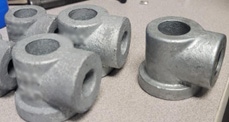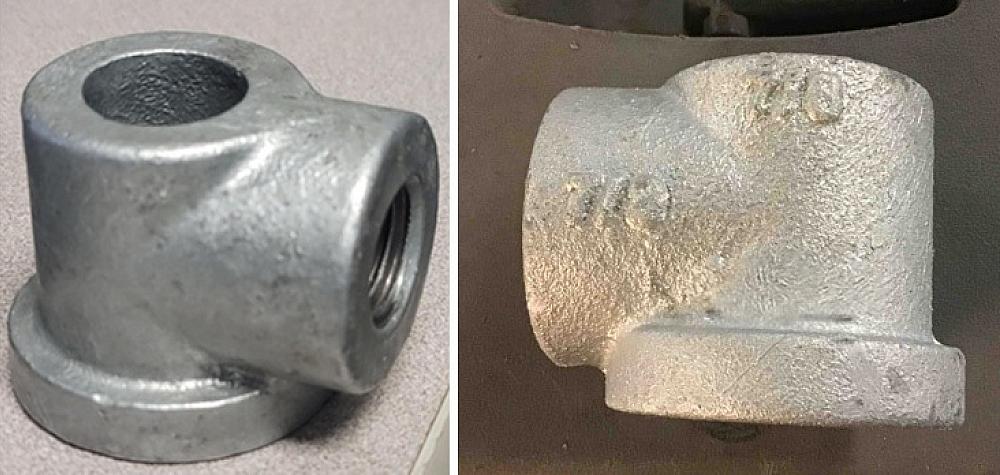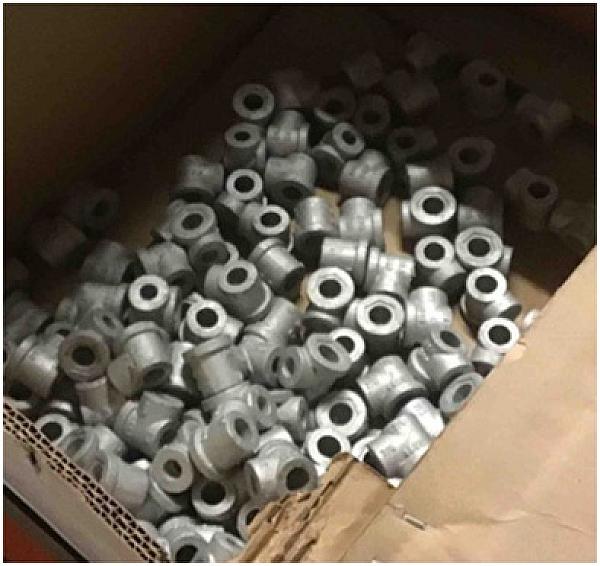Galvanizing Castings

What procedures or specs should be followed to ensure a quality HDG coating when galvanizing steel castings or cast iron?
The casting process involves pouring molten steel into pre-shaped molds, allowing it to cool and harden into the desired form. While hot-dip galvanizing remains a trusted method for protecting these castings from corrosion, it’s important to recognize castings sometimes react differently than standard carbon steel during galvanizing.
The steel used in cast iron typically contains at least 2% carbon, along with elevated levels of silicon and phosphorus. Silicon concentrations around 1% are common, and some castings can reach as high as 3% (Table 1). These chemical characteristics have a direct impact on the galvanizing process, often resulting in coatings that are thicker and rougher than those seen on traditional carbon steel. The initial surface condition of the casting is also crucial—parts that leave the foundry with a smoother finish will generally produce a smoother galvanized coating. For example, castings machined to remove extraneous material before galvanizing are likely to experience thinner coatings in the machined area despite identical steel chemistry elsewhere on the part. As many in the industry say, “rough in, rough out.”
Table 1: Examples of Carbon and Silicon content for common types of cast iron.
| Type | Carbon (%) | Silicon (%) |
| Grey Iron | 2.5-4.0 | 1-3 |
| Ductile Iron | 3.0-4.0 | 2-3 |
| Malleable Iron | 2.16-2.90 | 0.9-1.9 |
When it comes to initial galvanizing appearance, castings are known for their variability. It’s not unusual to see parts from the same batch range from shiny to dark matte gray (Figure 1). High silicon content accelerates the growth of zinc-iron alloy layers during galvanizing, which can consume the shinier eta layer as the part cools. Process variables like spin time, withdrawal rate, and cooling methods may also influence the final appearance and thickness of the coating, but to a lesser degree. No matter the initial visual appearance of the product, all galvanized castings will take on a uniform matte gray appearance and benefit from the superior corrosion protection provided by hot-dip galvanizing.

When cast iron is used in assemblies alongside carbon steel, achieving consistent cleanliness and appearance across all components can be challenging due to the different preparation requirements at the galvanizing plant. Occasionally the galvanizer and customer may need to come to an agreement on additional precautions to avoid roughness and pitting.

Blast cleaning or tumble blasting the castings before hot-dip galvanizing is recommended to improve coating quality and remove embedded sand, graphite, and other residues that can survive the galvanizer’s standard cleaning process. Bare spots on the finished product are usually the result of these contaminants. Using grit or a combination of grit and shot during blasting is the most effective way to clean castings thoroughly and promote a uniform finish. It’s also important to address any surface flaws, such as shrinkage holes or residual graphite, before galvanizing, as these can cause defects in the final coating.
Design and geometry play the most significant role in galvanizing outcomes. Simple, small castings like levers, clamps, and bushes are easy to galvanize if the material and surface are suitable. For larger pieces, use uniform thickness and balanced designs to prevent distortion or thermal stress cracking. Always use large fillet radii, large pattern numbers, and avoid sharp corners and deep recesses so that blasting or tumble blasting can be effective at improving coating quality.
In summary, galvanizing cast iron and steel castings demands a deeper understanding of material chemistry, surface preparation, and process control than standard carbon steel. By paying close attention to these factors, it is possible to achieve durable, high-quality HDG coatings, even if the appearance isn’t always perfectly uniform. Setting realistic expectations and communicating the potential for variation is key to successful outcomes when galvanizing castings.
© 2025 American Galvanizers Association. The material provided herein has been developed to provide accurate and authoritative information about after-fabrication hot-dip galvanized steel. This material provides general information only and is not intended as a substitute for competent professional examination and verification as to suitability and applicability. The information provided herein is not intended as a representation or warranty on the part of the AGA. Anyone making use of this information assumes all liability arising from such use.



